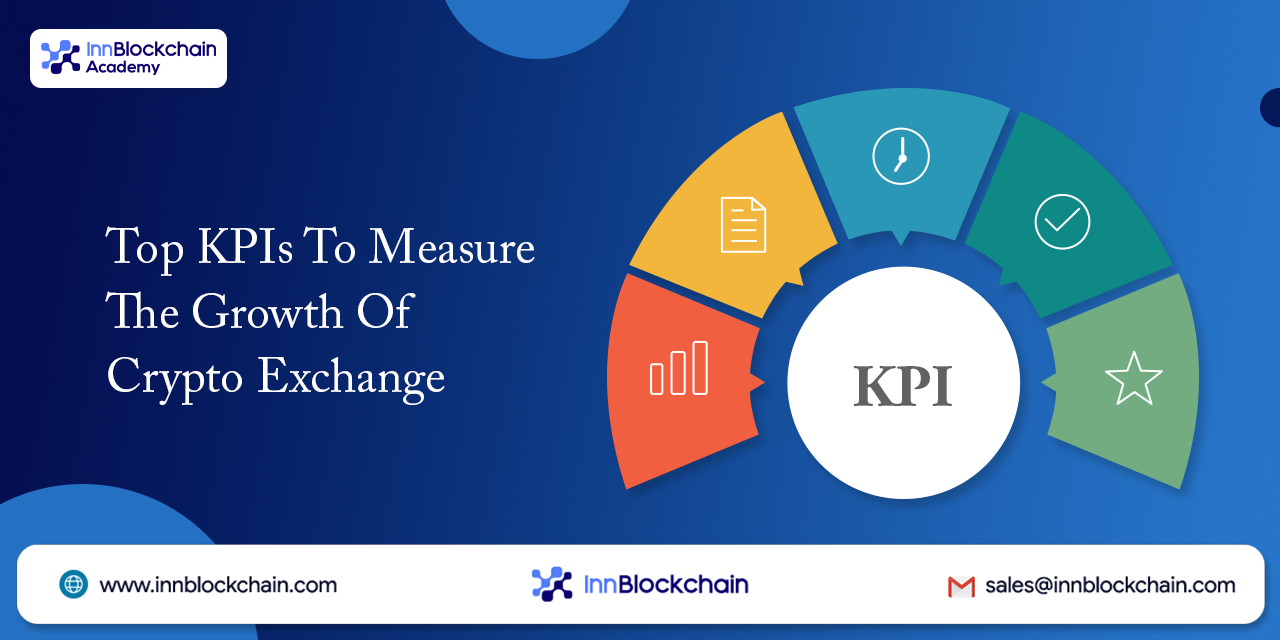I believe that you may be the owner of a crypto exchange platform. In light of this, here you are ready to grab knowledge about crypto exchange KPIs for your startups.
Yes, it is most necessary to have better knowledge about your business KPIs, as it will guide you to concentrate on the most essential part of your business.
In this blog, we will explore the KPIs for crypto exchange in detail, by discussing their value, calculation methods, and how they help drive business growth. By tracking and optimizing these KPIs, your crypto exchange business will not only survive but also thrive in the rapidly evolving landscape of 2025.
Let’s move on…
What are KPIs?
Key Performance Indicators (KPIs) are quantifiable metrics utilized to estimate the success of the project. KPIs are essential tools to predict the area for improvement, measure progress, and make informed decisions. KPIs differ based on the nature of the project or business but include metrics related to strategic goals, financial performance, operation efficiency, and customer satisfaction. Continuous monitoring and tracking of KPIs helps to gain valuable insights about performance. So that you can make strategic adjustments as required. To be precise, KPIs allow businesses to concentrate on activities that drive success and help them achieve their long-term objectives.
Common Crypto Exchange KPIs
KPIs for the cryptocurrency exchange can be divided into several types depending on the particular sector, business model, and operation of the exchange. Here are the most common KPIs for crypto exchanges:
Trading Performance KPIs:
- Average Trading Volume
- Market Share
- Spread
- Order Execution Time
- Trade Rejection Rate
- Liquidity Metrics
Community Engagement KPIs
- Number of Active Users
- Level of engagement on social media channels
- User Acquisition Cost (CAC)
- User Retention Rate
Customer Satisfaction KPIs:
- Customer Satisfaction (CSAT) Score
- Resolution time
- Response time
Security and Trust KPIs:
- Security Incidents
- Compliance Adherence
- Audit Trail
Financial KPIs:
- Revenue
- Profit Margin
- Cost per Acquisition (CPA)
Trading Performance KPIs
Trading performance KPIs are the metrics utilized to estimate the efficiency and effectiveness of the trading activity taking place within the exchange. Some of the common trading performance KPIs include Average Trading Volume, Market Share, Spread, Order Execution Time, Trade Rejection Rate, and Liquidity. These metrics provide valuable insights regarding the performance of trading strategies, risk management practices, and overall profitability.
By the following KPIs, you can easily assess trading performance over time, identify areas for enhancement, and data-driven decisions to optimize your trading strategies to attain your financial goals.
Average Trading Volume
The trade volume is a KPI that measures the average number of cryptocurrency units that have been traded within a particular period on the crypto exchange platform.
Average Trade volume = Total trading volume / Number of trading days
Market Share
It is the percentage of total cryptocurrency trading volume that occurs on a specific exchange compared to the total market trading volume.
Market Share = (Total Market Trading Volume / Exchange’s Trading Volume) × 100
Spread
Spread KPIs measure the difference between the highest buying price (Ask price) and the lowest selling price (Bid price) of specific cryptocurrency pairs. It represents the liquidity and trading efficiency of the exchange and also the cost of executing trades.
Spread=((Ask Price−Bid Price) / Ask Price)×100
Order Execution Time
It represents the average duration between the trading order placed by the user and the completion of order execution by the exchange. It includes the time taken for the order to be matched with a counterparty and for the trade to be executed.
Order Execution Time = Time of Order Fulfillment − Time of Order Placement
Trade Rejection Rate
It measures the percentage of trade orders that are rejected or not executed due to various reasons, such as insufficient funds, price fluctuations, or market conditions, relative to the total number of trade orders submitted by users within a specific time period.
Trade Rejection Rate = (Number of Rejected Trades / Total Number of Trades)×100
Liquidity Metrics
It assesses the depth and efficiency of its order book, denoting the ease with which assets can be bought or sold without significantly affecting their prices. These metrics are crucial for traders, as higher liquidity typically leads to tighter spreads and lower transaction costs.
Bid – Ask Spread Ask Price − Bid Price
Community Engagement KPIs
KPIS for community engagement are essential for the success of cryptocurrency services in 2025. Metrics like the Number of Active Users, Level of engagement on social media channels, User Acquisition Cost (CAC), and User Retention Rate are the key indicators of community involvement.
Monitoring feedback and sentiment analysis from the community can provide insights regarding user satisfaction and areas for enhancement. In addition, tracking the growth of the community helps to measure the vitality of the community. By concentrating on these KPIs, your crypto exchange development service can foster a robust and engaged community, thus helping to build brand loyalty and drive adoption in the competitive crypto world of 2025.
By focusing on the following KPIs, you can build brand loyalty, thus helping to develop a strong and engaged community to sustain in the competitive crypto market of 2025.
Number of Active Users
The number of active users is a KPI that measures the total number of users who are actively participating in a crypto exchange within a particular time frame, which may be on a daily basis or weekly basis or monthly basis.
No of active users = Total number of unique users within the particular time frame
Level of engagement on social media channels
It measures the extent to which users interact with the social media channels. It indicates the level of interest, interaction, and involvement of users with social media channels, such as likes, shares, comments, and overall participation in discussions and activities.
Engagement Rate=Total Followers / Total Engagements×100
User Acquisition Cost (UAC)
User Acquisition Cost (UAC) for a crypto exchange refers to the average cost incurred to acquire a new user for the exchange. It includes various expenses associated with marketing, advertising, promotions, and other activities aimed at attracting new users to the exchange.
User Acquisition Cost (UAC) = Total Cost of Acquisition / Number of New Users Acquired
Percentage of returning users
It is used to measure the rate at which users return to the exchange to continue with the transaction or interaction.
Percentage of returning users = (No of returning users / Total number of users) * 100
Customer Satisfaction KPIs:
Customer satisfaction is one of the important KPIs for the success of your crypto exchange development services in 2025. Key metrics like Customer Satisfaction (CSAT) Score, Resolution time, and Response time provide effective knowledge about customer service.
Moreover, tracking user feedback via reviews, surveys, and social media will help to predict the areas for enhancement in order to improve the overall customer experience.
By focusing on the following KPIs, your crypto exchange development services can develop a strong customer relationship, improve customer loyalty, and you can also differentiate yourself from your competitors.
Customer Satisfaction (CSAT) Score
The CSAT measures the user’s level of satisfaction with the service provided by the crypto exchange. It is entirely based on a survey, where users rate their satisfaction on a scale of 1 to 5.
CSAT = (No of satisfied customers / Total number of respondents) * 100
Response Time
This KPI is the average amount of time required by the exchange’s customer support team to respond to user’s issues, requests, or inquiries.
Response Time = Total Time Spent Responding to Inquiries / Number of Inquiries
Resolution Time
This KPI is used to measure the average time taken by the exchange’s support team to fix the issues or tickets raised by them.
Resolution Time = Total Time Spent Resolving Issues / Number of Issues Resolved
Security and Trust KPIs
KPIs for security and trust are vital for the success of your crypto exchange platform. Metrics like Security Incidents, Compliance Adherence, and Audit Trail are key indicators of security KPIs.
Monitoring users trust metrics like ratings, and reviews provides insights about the trustworthiness of your crypto exchange development service.
In addition, tracking security practices like 2FA and encryption helps to mitigate security risks and develop user trust. By focusing on the following KPIs, you can improve your exchange’s security, and you can also safeguard your users’ assets. This makes your exchange a trusted one in the competitive 2025 crypto market.
Security Incidents
It measures the number of breaches or incidents that occur on the exchange within a specific period.
Security Incidents = Number of breaches or incidents
Compliance Adherence
It measures the extent to which the exchange complies with relevant regulatory requirements, industry standards, and internal policies governing its operations.
Compliance Adherence = Number of Compliance Violations / Total Compliance Requirements × 100
Audit Trail
Audit Trail KPI refers to the systematic recording and documentation of all transactions, activities, and events occurring on the exchange’s platform. It involves maintaining detailed logs and records that can be used for monitoring, analysis, and regulatory compliance purposes.
Financial KPI
KPIs related to finance include metrics like Revenue, Profit Margin, and Cost per Acquisition (CPA). Financial metrics are driven from the company’s financial statements. However, internal management makes use of the following financial metrics to examine the issues of the company that management needs to rectify. For instance, the company uses variable costing to recalculate account balances for internal analysis.
Revenue
It measures the total income generated by the exchange from various sources, including trading fees, listing fees, withdrawal fees, and other revenue streams. It indicates the exchange’s financial performance and revenue-generating capabilities.
Revenue = Total Trading Fees + Total Listing Fees + Total Withdrawal Fees + Other Revenue Streams
Profit Margin
It measures the percentage of revenue retained by the exchange after deducting operating expenses and other costs associated with running the business.
Profit Margin (%)= (Net Profit / Total Revenue) × 100
Cost per Acquisition (CPA)
It measures the average cost incurred to acquire a new customer or user for the exchange’s platform.
Cost Per Acquisition = Total Cost of Acquisition / Number of New Users
From the above-stated KPIs, you can explore your crypto exchange business and what value you are holding on to. These KPIs will help you to drive more strengths for your business. This helps to create positive values among your customers.
I hope it will be simple to calculate your crypto exchange with all these efficient crypto exchange KPIs that are essential for your business enhancements.
Hope all these metrics will give clear idea on how to evaluate the crypto exchange platform. To gain more knowledge, you can approach InnBlockchain, crypto exchange development company help you in all the way for your platform success.






